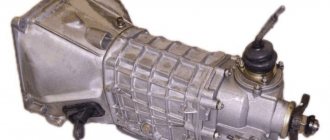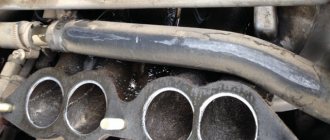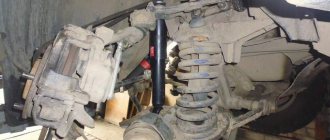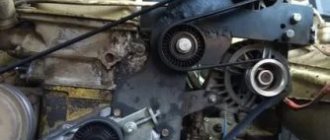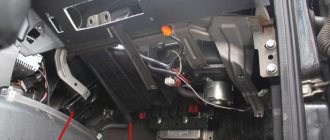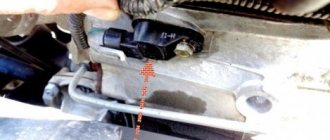Using a syringe with a tube, completely pump out the fluid from the power steering reservoir.
Niva Chevrolet Niva Chevrolet replacing the heater hose using the dentist's method
If the power steering fails, it is possible to drive the car, but the steering wheel will be difficult to turn and will become heavy. To partially replace the power steering oil, you will need a syringe with a tube and the oil itself, enough so that at the end of the work it will no longer be dark.
[em]Continuation of the report (+) - Alexander - What is the frequency of changing the power steering oil? I thought about just disconnecting the hose...
At this moment, you must not allow the power steering oil to completely drain from the reservoir into the system and allow air to be sucked in! You can drain everything old so that it doesn’t mix with the new when topping up.
To partially replace the power steering oil, you will need a syringe with a tube and the oil itself, enough so that at the end of the work it will no longer be dark. The fitting is located to the right of the gearbox axis in the top cover and is secured with 4 bolts in the center - adjusting the gearbox backlash; internal hexagon; replacing power steering hoses on a Chevrolet Niva; lock nut. Drive onto an overpass, or jack up the car so as to hang the front wheels of the Chevrolet Niva, in order to be able to easily rotate them with the engine not running.
The oil itself is not aggressive to your hands or paintwork, like brake fluid, for example? The screw is located on the gearbox cover, which is secured with four bolts. Am I now studying the picture in the manual?
You can drain everything old so that it doesn’t mix with the new when topping up.
Next, assemble the line, pour new water into the reservoir, one swings the steering wheel between the extreme positions without starting the engine, the other unscrews the fitting with a key of 8, as on the brake fittings, the cone-to-cone fit is the same and bleeds the air. In the process, add oil to the reservoir. When liquid flows through the fitting, close it.
Start the engine, one rotates the steering wheel as stated above, the other, in extreme positions, bleeds air through the fitting, CAUTION, as there is a possibility of getting a jet in the face, there is pressure on a running engine. As soon as one fluid flows, consider the process complete, tighten the fitting well. This sequence of actions was carried out personally on the advice of a person from the Elex warranty station; I did not find an accessible manual anywhere.
After replacing the steering wheel became even lighter, 1 click the flight was normal. After replacing, wash your face and hands; no traces or irritation were noticed. The fitting is located to the right of the gearbox axis in the top cover and is secured with 4 bolts; in the center there is an internal hexagon and a lock nut for adjusting the gearbox play.
During operation, Chevrolet Niva power steering fluid can leak in various places, most often through hoses. As a result, the power steering oil level will drop.
Driving without fluid in the Chevrolet Niva's power steering puts you at risk of breaking the power steering pump, which costs a lot of money, since it will run dry. As a result, it will suffer serious damage and fail.
Niva Chevrolet Niva Chevrolet replacing the heater hose using the dentist's method
Intensive use of the Chevrolet Niva makes the color of the power steering oil darker over time, often with a burning smell. This is a reason to think about replacing it.
Overheating of the oil often occurs when the steering wheel is held in the extreme position for a long time, until it boils; the pressure in this case is maximum.
You should also not leave your car parked for a long time with the steering wheel turned all the way. There are two ways to replace the fluid in the Chevrolet Niva power steering: To partially replace the power steering oil, you will need a syringe with a tube and the oil itself, enough so that at the end of the work it will no longer be dark.
Transmission Chevrolet Niva (Chevrolet Niva). Structure and operation of mechanisms. (copy of video)
Using a syringe with a tube, completely pump out the fluid from the power steering reservoir. Fill the reservoir with new fluid to the MAX level.
Chevrolet Niva 2005, 80 l. With. — scheduled maintenance
We start the engine and turn the steering wheel left and right to the extreme position. Drive onto an overpass, or jack up the car so as to hang the front wheels of the Chevrolet Niva, in order to be able to easily rotate them with the engine not running.
Use a syringe with a tube to remove as much old oil as possible from the tank. Now you need to determine through which hose the oil enters the Chevrolet Niva power steering expansion tank - this is the return, and through which it leaves and goes to the power steering pump. Disconnect the hose through which the oil enters the return tank.
Tags: ignition, coils, Logan, malfunction, Renault
- Related Posts
- Maintenance and repair of Mitsubishi ASX (Mitsubishi ASX) - Kolesa.ru
- Toyota Corolla E12 » Blog Archive » Replacing lamps
- Replacing the cabin filter on Renault Megane 3 / Fluence - online magazine about Renault
« Previous entry
Installing power steering, replacing hoses and power steering fluid for Chevrolet Niva (VAZ 2123)
Replacing power steering fluid in a Chevrolet Niva (VAZ 2123)
Actually, having stopped by to specially adjust the headlights before the maintenance, the local master, who was starting his own business, decided to lure me to his place by opening the power steering reservoir cap and pleased me with a quick replacement, so the oil there was dark in color and smelled of burning. He asked for 1000 rubles for the work. Ha! Yes, I'm over a thousand... In short, we climbed onto the glorious Lacetti club www.lacetti-club.ru/vb_forum/index.php where I found a detailed description of the operation www.lacetti-club.ru/vb_fo...php?p=755031&postcount=72 But there was no photographs. But it will be easier to navigate using the pictures. Even in driving schools they study traffic rules from pictures. I decided to correct this misunderstanding. In general, I found some time and got to work. To replace, we will need the following tools: a medical syringe
Medical, because it is easier to find and purchase. Personally, I took it at the first aid station at work. You can also use oil, then there will be less body movements. Narrow-nose pliers for removing clamps
containers where to drain the waste oil decided to pour Ravenol
He was chosen based on one phrase on the label that he had GM specifications. True, no one explained why FIII and at the office. There is no information about this on the website. But I don't think it's any worse than the regular Dexron III. To be honest, I was leaning towards Castrol. Dexron Vi
But one line scared me away from buying it: it’s not compatible with Dexron III. But the Lacetti is filled with either D II or D III from the factory, in models since 2009 D IV. And since they are not compatible, at least this Castrol, then what for is it needed! Let's get started. We hang up the front wheels. There were no “goats”, and neither was the second jack. Therefore, improvised materials were used.
Remove the cap from the power steering reservoir
Two pipes are suitable for it: to the power steering pump (lowest) and return (higher). They will be useful to us.
We take a syringe and start pumping. Having reached the bottom, we find that the syringe no longer takes liquid, but it remains in the tank.
What to do? We place a container under the first pipe that goes to the pump and throw it off, thereby allowing the liquid to flow out.
After that, we put the pipe back on and remove the return line.
This is necessary to expel any remaining liquid in the system. That is why we hung the wheels, to make it easier to turn the wheels, because the engine is turned off and, if you start it, the pump can grab air, which is fraught. In general, we place a container under the hose and turn the steering wheel left and right until it stops and back. And we do this until liquid stops flowing from the hose.
After this, we put the return hose back on, fill the tank to the level and, again, without starting the engine, swing the steering wheel left and right, pumping the system. Adding fluid as the reservoir empties, without allowing it to completely empty, in general, like with brakes. Rotate the steering wheel until the fluid stops decreasing. After this, you can start the engine. At first it makes noise... loudly. Then it calms down and the level naturally drops, but not much. Top up. We turn the steering wheel again, but now try not to turn it all the way, and if it works, don’t hold it in this position for a long time - it might squeeze it out. We make sure that the fluid is at the same level, turn off the engine, and lower the car to the ground with all four wheels. In general, this completes the operation to replace the power steering fluid. We hide the tool in its place, we also put the work somewhere else, but without harming the environment. Wednesday. Interesting observations: according to the manual, the system has 1.1 liters. I bought a liter of power steering fluid, turned the steering wheel long and hard, I don’t know how much I pumped out with a syringe, I poured it straight into a bucket, but there was still a little fluid left in the canister. Gram 200.
At the same time, after a run of more than 50 kilometers with various kinds of turns, the level remains level.
Replacing power steering hoses for Chevrolet Niva (VAZ 2123)
Replaced the power steering low pressure hoses, the high pressure hose is normal. So, the process: we remove the air vent for ease of work, remove the three low-pressure hoses by first loosening the clamps and preparing a jar to drain the power steering fluid. We measure out the new hoses and put them in place, fill the reservoir full with fluid, put the air vent in place, start the engine, turn the wheels left and right until it stops, turn it off - add fluid in the middle of the marks, pump the power steering by unscrewing the drain plug and letting out the air, wait, When the engine has cooled down, check the fluid level in the tank and add more if necessary. The next time we start, we listen to the power steering - it doesn’t make noise, which means everything is OK. The old hoses were all dry and began to leak heavily when removed.
Installing power steering on a Chevrolet Niva (VAZ 2123)
Nothing has happened to the car yet, but during this time parts for installing power steering were purchased. 1. Steering gear from Chevrolet Niva 2. Power steering pump from Chevrolet Niva 3. Power steering pump pulley for V-belt 4. Crankshaft pulley for V-belt 5. Extended nut for crankshaft 6. Belt 7. Power steering pump mount from 21214 Niva 8. Reservoir for power steering fluid 9. Reservoir mount
Spare parts for power steering
All that remains is to purchase a steering cardan and you can install it. Yesterday I looked under the hood and realized that the original fan was interfering with the normal installation of the power steering - I ordered an electric one from 21214. All this stuff will be installed soon.
Yesterday I connected all the hoses, filled in the fluid, and bled the system. Today I started the car and everything works as it should. It’s not customary to turn the steering wheel in a Niva with one hand. Along the way, I changed the front oil seal on the crankshaft, the chain tensioner and the pump.
New oil seal
Cardan 21214
All is ready
Overall plan
I also painted the frame above the radiator
Painted
In general, emotions are overwhelming - the power steering is working, the fans are ventilating.
https://www.drive2.ru/l/288230376152023925/, https://www.drive2.ru/l/4899916394579319801/, https://www.drive2.ru/l/6329812/, https://www .drive2.ru/l/6550376/
Rating 0.00 [0 Vote(s)]
Chevrolet Niva Snow Queen › Logbook › Replacing power steering hoses
The power steering hoses were “oaky” and cracked, some were even sweating oil.
The heat exchanger was all rusty and should start leaking any minute. It was decided to service the entire power steering comprehensively, for this we buy:
Fluorosilicone hoses (oil-gasoline resistant) 16 mm by 600 mm 12 mm by 1300 mm Spring clamps on them Oil tank GURA NIVA 2123 ZF 2123-3410010 or REMKOM RK07001 (Is a system filter) Power steering oil radiator 2123-3408200 (heat exchange nickname) Mannol 8990 4pcs or Mannol CHF (2472) 2 pcs, approved CHF 11S
There is a good article about pentosin and dextron bmwservice.livejournal.com/18846.html
I also bought a 6mm silicone hose and spring clamps for it to install it on the clutch reservoir, since the standard hose had long since dried out and was leaking.
I placed the return hose in a bottle and plugged the outlet hole on the barrel. We fill in the fluid and pump the remaining old fluid through the wheels from stop to stop until clean, new fluid flows out. The engine did not start.
Bleeding the power steering system
(from the manual)
The need for bleeding occurs when air gets into the hydraulic system during repair work or when it loses its tightness during operation.
A sign of air in the system is the steering wheel jamming when you try to turn it sharply.
In addition, the pump makes increased noise when the steering wheel is turned, and the fluid in the reservoir usually foams.
You will need an 8 key.
1. With the steering wheel in the middle position, run the engine for 10–15 seconds.
2. Stop the engine without turning the steering wheel.
3. Turn the steering wheel all the way in one direction. Remove the protective cap from the air release valve
4. Unscrew the air release valve on the steering gear
5. turn the steering wheel all the way in the other direction
6. Without turning the valve, turn the steering wheel all the way in the other direction. In this case, air should come out of the valve, and then liquid.
7. Without touching the steering wheel, close the air release valve.
PURGING THE POWER STEERING SYSTEM FOR VAZ 2121, 2131
- Add oil to the power steering reservoir to the lower mark.
- We start the engine and at idle speed, check the oil level in the tank. If necessary, top up to the lower mark.
- Turn the steering wheel left and right as far as it will go several times and check the oil level in the tank. If necessary, top up to the lower mark.
- Remove the protective cap from the bleeder fitting.
- We loosen the tightening of the bleeder fitting (key “8”).
- We connect a transparent hose to it, the other end of which is lowered into an empty container.
- Unscrew the fitting 1/2 turn.
- When a continuous flow of liquid without air bubbles appears in the hose, tighten the fitting.
- Set the steering wheel to the middle position and let the engine run for another 2-3 minutes.
- Turn the steering wheel left and right as far as it will go several times and check the oil level in the tank. If the level drops again, then repeat steps 4-9.
Oil Change Guide
So, changing the power steering oil is an integral part of the maintenance of a Chevrolet Lacetti. The fluid replacement procedure can be performed at home.
What the replacement process looks like:
- First, you will need to jack up the front of the car, this is necessary so that the front wheels can rotate freely. If you don’t have jacks, then as an option, you can use a slippery surface, for example, ice, wet grass, etc.
- Next, open the hood and unscrew the filler plug of the power steering reservoir. Using a large medical syringe with a nozzle installed on it, it is necessary to pump out all the consumables from the tank.
- After that, look under the tank - there should be two pipes along them. The pipe that connects to the power steering pump must be disconnected, but before doing this, place a container under it, for example, a cut-off bottle. You need to wait until all the oil has left the system.
- Next, disconnect the second pipe - this is the so-called return pipe. The return line is marked in more detail in the photo. You also need to place a container under this hose, since oil will also come out of it. In order to pump out spent consumables from the power steering system as much as possible, the car’s wheels must be turned first completely to the right, and then completely to the left. In this case, in extreme positions it is necessary to pause for several minutes. This procedure is repeated until oil stops coming out of the return line.
- When the substance comes out, wipe the end of the first pipe you removed and try blowing into it. If there are any remaining consumables in the system, they must come out.
- Next, the pipe itself should be connected back to the expansion tank. After completing these steps, you can fill the tank with new consumables. In this case, the volume of the substance poured must correspond to the volume of drained oil, no more and no less. When filling, be guided by the marks marked on the tank - the volume of substance in it should be at a level between MIN and MAX.
- When the substance is poured, the power steering system is pumped. This stage is very important and cannot be skipped. Follow the instructions strictly, as these steps largely determine the effectiveness of the work done.
- So, with the engine turned off (don’t even think about starting it), you need to slowly turn the steering wheel to the right and left, to the extreme position. In this case, in each extreme position the steering wheel should be held for a few seconds, as you did earlier. When turning the steering wheel, make sure that the level of consumables in the expansion tank does not drop to a minimum. It is also advisable to prevent air from entering the system, otherwise this will cause the formation of an air lock. And this, in turn, will cause a hum and noise when turning the steering wheel, so be careful. If the volume of a substance decreases as a result of manipulation, it will need to be replenished. The procedure is repeated until the level of the substance in the expansion tank stops decreasing.
- After completing these steps, you can start the power unit. Immediately after starting, you can hear the power steering pump humming. Some car enthusiasts immediately check the pump, the pump itself and other elements of the system, but this is unnecessary, since the appearance of sound initially after replacement is normal. When the substance disperses throughout the system, all noise should disappear. When the engine is running, the procedure of turning the steering wheel to the extreme right and left is repeated, only there is no need to pause. Check the level of consumables in the expansion tank again and, if necessary, add the substance.
Photo gallery “Do-It-Yourself Replacement”
1. Return pipe under the tank
2. Disconnecting the hose
3. Collection of waste substances
Price issue
The cost of consumables will depend on the manufacturer, as well as the quality of the substance. For example, the cost of one liter of MOTUL Dexron IID today is about 600 rubles. A product that meets the same characteristics, only from the manufacturer Febi, costs around 420 rubles per liter, and from the manufacturer Castrol - approximately 520 rubles per liter.
The power steering fluid in the Chevrolet Niva is an oil that transmits resistance from the power steering pump to the hydraulic cylinder, and also lubricates all friction pairs.Oil circulation occurs through the hoses connecting the power steering units, including the Chevrolet Niva power steering expansion plastic tank, which has MIN and MAX marks to determine the level.
The power steering system itself is a Chevrolet Niva hydraulic system, part of the steering mechanism to make it easier to turn the steering wheel and set the trajectory. If the power steering fails, it is possible to drive the car, but the steering wheel will be difficult to turn and will become heavy.
We remind you once again that the Chevrolet Niva power steering system functions as long as possible,
Avoid long-term fixation of the steering wheel in the extreme position when driving, do not park the car with the steering wheel turned all the way. This puts enormous strain on her, especially in winter.
How to determine the need to change the power steering oil?
On the Chevrolet Lacetti, Chevrolet Cruze and many other models of this ], power steering fluid[/anchor] is an important consumable, the condition of which determines the operation of the unit as a whole. Unfortunately, the technical regulations do not indicate the exact timing of oil changes, but many car enthusiasts claim that after 15 thousand kilometers the fluid should be changed in any case (video author - Nikita Kislyakov).
What signs may indicate the need for an oil change:
- the liquid has changed its color, become darker, and may contain sediment;
- consumables smell like burning;
- the steering wheel has become more difficult to turn;
- When turning the steering wheel, sounds uncharacteristic of its operation may be heard.
How to bleed the clutch on a Niva Chevrolet: photos and videos
Clutch bleeding should be done when the clutch is not fully engaged.
The basics of bleeding the clutch in the video below:
Bleeding the clutch on a Chevrolet Niva
When everything you need for work is at hand, you should perform the following activities:
- Open the reservoir where the liquid is poured and fill it to the neck. It is located in the engine compartment.
Clutch bleeding fluid
- A hose should be put on the fitting of the system cylinder, and its other end is immersed in the container.
- Next, the assistant depresses the clutch pedal (3-4 times) and then holds it depressed.
- With the pedal depressed, unscrew the valve and bleed the fluid in the system. After this, the valve closes and pressure is created in the system again.
- During the process, you need to check the fluid level in the tank. If necessary, it is topped up.
- After pumping, add fluid to the reservoir up to the MAX mark.
- With the engine warm and idling, depress the clutch pedal and engage the gear. During the process, no grinding noise should be heard in the gearbox.
- When accelerating a car, it must gain speed in proportion to the increase in crankshaft speed. If the engine is running at high speeds, but the car does not accelerate dynamically, it means that the clutch is slipping. It will need to be repaired.
Bleed the clutch by pressing and holding the pedal
The procedure should be repeated until clear liquid comes out of the system. There should also be no air bubbles in it.
Controlling the color of the liquid and air bubbles
Checking the clutch condition
Before a test drive, check how the gears engage with the clutch depressed.
To check the technical condition of the clutch, you will need:
How to determine the need to bleed the clutch
This can be determined because when you engage any gear, you will hear a grinding noise in the box.
This situation may indicate that air has appeared in the system. This can happen as a result of replacing both the fluid itself and system parts.
To do this work yourself, you should have a set of tools, replacement fluid, an empty container and a tube. It will be convenient to carry out the work with an assistant. Pumping should be done on an inspection hole or overpass.
Useful tips
You should not constantly keep your foot on the clutch pedal while the car is moving.
In this case, the disc will slip and wear out faster. And also the release bearing will work under load, as a result of which its life will be reduced. For the same reason, you should not keep the clutch pedal depressed for a long time. This can happen, for example, in a traffic jam.
conclusions
Knowing these points, you can independently determine the quality of the clutch and, if necessary, pump it.
